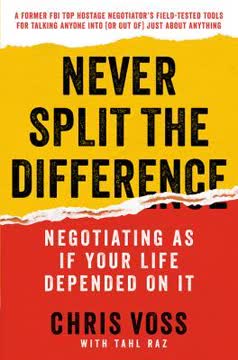Key Takeaways
1. Embrace reality and deal with it through radical truth and transparency
Truth—or, more precisely, an accurate understanding of reality—is the essential foundation for any good outcome.
Radical truth and transparency are fundamental principles for success. They involve being honest about the current reality, including mistakes and weaknesses, and sharing information openly. This approach leads to better decision-making, faster learning, and stronger relationships.
Benefits of embracing reality:
- Faster problem-solving
- Improved trust and collaboration
- Accelerated personal and organizational growth
By facing reality head-on, individuals and organizations can:
- Identify and address issues more effectively
- Make better-informed decisions
- Build a culture of continuous improvement
2. Use the 5-Step Process to achieve your goals and solve problems
Goals are typically achieved in steps: 1) have clear goals, 2) identify and don't tolerate problems, 3) diagnose problems to get at their root causes, 4) design plans that will get you around them, and 5) do what's necessary to push these designs through to results.
The 5-Step Process is a powerful framework for achieving goals and solving problems. It provides a structured approach to turning vision into reality.
Breakdown of the 5-Step Process:
- Set clear goals: Define what you want to achieve
- Identify problems: Recognize obstacles preventing goal achievement
- Diagnose root causes: Understand the underlying reasons for problems
- Design solutions: Create plans to overcome obstacles
- Execute and follow through: Implement solutions and persist until goals are achieved
This process can be applied to personal goals, business challenges, or any complex problem. By systematically working through each step, individuals and organizations can increase their chances of success and continually improve their performance.
3. Practice radical open-mindedness to overcome your ego and blind spots
Radical open-mindedness is motivated by the genuine worry that you might not be seeing your choices optimally.
Radical open-mindedness is the willingness to consider that you might be wrong and to actively seek out perspectives that challenge your own. This approach helps overcome cognitive biases and ego-driven decision-making.
Key aspects of radical open-mindedness:
- Actively seeking out diverse viewpoints
- Embracing thoughtful disagreement
- Recognizing and challenging your own biases
Benefits of practicing radical open-mindedness:
- Improved decision-making
- Enhanced learning and personal growth
- Stronger relationships and collaboration
To cultivate radical open-mindedness, regularly seek feedback from others, encourage constructive criticism, and create an environment where challenging ideas is welcomed and rewarded.
4. Understand that people are wired differently and leverage their unique strengths
We all have strengths and weaknesses that come from our differences.
Recognizing cognitive diversity is crucial for building effective teams and organizations. People have different ways of thinking and processing information, which can be leveraged to improve decision-making and problem-solving.
Common differences in thinking styles:
- Big picture vs. detail-oriented
- Creative vs. analytical
- Introvert vs. extrovert
- Planner vs. spontaneous
To leverage cognitive diversity:
- Assess individual strengths and weaknesses
- Assign roles that align with natural abilities
- Create diverse teams with complementary skills
- Encourage collaboration and knowledge sharing
By understanding and embracing these differences, organizations can create more innovative solutions, make better decisions, and build stronger teams.
5. Make decisions effectively by triangulating with believable people
Find the most believable people possible who disagree with you and try to understand their reasoning.
Triangulation is the process of seeking out multiple perspectives, especially from credible sources, to make better decisions. This approach helps overcome individual biases and blind spots.
Steps for effective triangulation:
- Identify believable people with relevant expertise
- Seek out diverse viewpoints, especially those that challenge your own
- Analyze and compare different perspectives
- Synthesize information to make a well-informed decision
Benefits of triangulation:
- Reduced decision-making errors
- Increased confidence in decisions
- Improved learning and understanding of complex issues
By consistently practicing triangulation, individuals and organizations can make more robust decisions and continuously improve their decision-making processes.
6. Cultivate meaningful work and relationships within your organization
Meaningful relationships and meaningful work are mutually reinforcing, especially when supported by radical truth and radical transparency.
Creating a culture of meaningful work and relationships is essential for long-term organizational success. This involves aligning individual and organizational goals, fostering open communication, and building trust among team members.
Key elements of meaningful work and relationships:
- Shared purpose and values
- Open and honest communication
- Mutual respect and trust
- Opportunities for growth and development
Strategies for cultivating meaningful work and relationships:
- Clearly articulate organizational mission and values
- Encourage regular feedback and open dialogue
- Provide opportunities for collaboration and team-building
- Recognize and reward contributions to organizational goals
By fostering an environment of meaningful work and relationships, organizations can improve employee engagement, retention, and overall performance.
7. Constantly train, test, evaluate, and sort people to build a great team
Recognize that the most important decisions you can make are who you choose as your Responsible Parties.
Building a great team requires ongoing effort to develop talent, assess performance, and ensure the right people are in the right roles. This process is critical for maintaining organizational excellence.
Key components of effective people management:
- Rigorous hiring processes
- Continuous training and development
- Regular performance evaluations
- Willingness to make tough personnel decisions
Steps for building and maintaining a great team:
- Define clear roles and responsibilities
- Provide ongoing training and feedback
- Regularly assess performance against objectives
- Make data-driven decisions about promotions, reassignments, or terminations
By consistently focusing on team development and optimization, organizations can build a high-performing workforce capable of achieving ambitious goals.
8. Design your machine (organization) to achieve your goals
Think about your problem as a set of outcomes produced by a machine.
Viewing your organization as a machine helps in designing and optimizing processes to achieve desired outcomes. This perspective allows for systematic improvement and problem-solving.
Key elements of organizational design:
- Clear goals and metrics
- Well-defined processes and workflows
- Appropriate allocation of resources
- Feedback mechanisms for continuous improvement
Steps for designing an effective organizational machine:
- Define desired outcomes and key performance indicators
- Map out processes and identify potential bottlenecks
- Assign roles and responsibilities based on individual strengths
- Implement systems for monitoring and improving performance
By thinking of the organization as a machine, leaders can more effectively identify and address inefficiencies, leading to better overall performance.
9. Perceive problems, diagnose their root causes, and design solutions
Don't get distracted by shiny objects.
Problem-solving is a critical skill for organizational success. It involves identifying issues, understanding their underlying causes, and developing effective solutions.
Steps for effective problem-solving:
- Perceive problems: Actively look for issues and inefficiencies
- Diagnose root causes: Analyze the underlying factors contributing to problems
- Design solutions: Develop comprehensive plans to address root causes
- Implement and monitor: Execute solutions and track their effectiveness
Key principles for problem-solving:
- Focus on the most important issues
- Look for patterns and systemic problems
- Encourage open communication about challenges
- Learn from both successes and failures
By systematically addressing problems and their root causes, organizations can continuously improve and adapt to changing circumstances.
10. Manage like someone operating a machine to achieve a goal
Your part in an employee's personal evolution begins with a frank assessment of their strengths and weaknesses, followed by a plan for how their weaknesses can be mitigated either through training or by switching to a different job that taps into their strengths and preferences.
Effective management involves overseeing the organizational machine, ensuring all components work together to achieve desired outcomes. This requires a systematic approach to people, processes, and problem-solving.
Key aspects of managing like a machine operator:
- Setting clear goals and metrics
- Monitoring performance and identifying issues
- Making data-driven decisions
- Continuously optimizing processes and people
Strategies for effective management:
- Develop comprehensive dashboards to track key performance indicators
- Implement regular review processes to assess progress and identify issues
- Foster a culture of continuous improvement and learning
- Align individual and team goals with overall organizational objectives
By adopting this approach, managers can more effectively guide their organizations toward success, making informed decisions and adapting to changing circumstances.
Last updated:
FAQ
What's Principles by Ray Dalio about?
- Personal and Professional Insights: Principles combines Ray Dalio's personal journey with the principles he developed throughout his career as a successful investor and entrepreneur.
- Life and Work Principles: The book is divided into three parts: Where I’m Coming From, Life Principles, and Work Principles, each outlining fundamental truths guiding Dalio's decision-making.
- Focus on Learning: Dalio emphasizes learning from mistakes and experiences, advocating for a systematic approach to decision-making based on repeatable principles.
Why should I read Principles by Ray Dalio?
- Valuable Life Lessons: The book offers insights into navigating life's challenges and making better decisions, sharing lessons from Dalio's successes and failures.
- Framework for Success: Readers gain a framework for understanding reality and making effective choices applicable in various life aspects.
- Unique Perspective: Dalio combines personal anecdotes with practical advice, making it relatable and actionable for readers from all backgrounds.
What are the key takeaways of Principles by Ray Dalio?
- Embrace Reality: Accept the truth of situations, no matter how uncomfortable, and use that understanding to inform decisions.
- Radical Open-Mindedness: Be open-minded and transparent in relationships, fostering an environment for honest feedback and constructive criticism.
- Systematic Decision-Making: Use documented principles to guide actions, helping individuals and organizations learn from past experiences and improve over time.
What is the 5-Step Process in Principles by Ray Dalio?
- Define Your Goals: Clearly identify what you want to achieve, setting the foundation for the entire process.
- Identify Problems: Recognize obstacles hindering your goals, requiring an honest assessment of the current situation.
- Diagnose Problems: Analyze the root causes of identified problems to develop effective solutions.
- Design Solutions: Create actionable plans to address diagnosed problems, requiring creativity and experimentation.
- Implement and Evaluate: Put solutions into action and continuously evaluate their effectiveness, allowing for adjustments and improvements.
How does Ray Dalio define "believability" in Principles?
- Credibility Based on Experience: Believability is the degree to which a person's opinions can be trusted based on past successes and relevant experience.
- Weighting Opinions: Opinions should be weighted according to the believability of the individuals providing them, giving more credible voices greater influence.
- Continuous Learning: Believability can change over time as individuals gain more experience and knowledge, encouraging a culture of learning.
What is the concept of "radical transparency" in Principles by Ray Dalio?
- Open Communication: Share information openly within an organization, allowing everyone to see decision-making processes and outcomes.
- Encouraging Feedback: Radical transparency encourages honest feedback without fear of repercussions, leading to continuous improvement.
- Building a Stronger Culture: It is essential for creating a strong organizational culture, aligning everyone towards common goals with the best available information.
How does Ray Dalio suggest handling mistakes in Principles?
- Embrace Mistakes: View mistakes as opportunities for learning rather than failures, encouraging reflection on errors for valuable lessons.
- Document and Analyze: Keep a record of mistakes and analyze their root causes to prevent similar errors in the future.
- Encourage Open Discussion: Create an environment where mistakes can be openly discussed without fear of punishment, allowing teams to learn collectively.
What role does meditation play in Ray Dalio's life and work according to Principles?
- Mental Clarity: Meditation provides mental clarity and emotional stability, helping Dalio approach challenges with a calm and open mind.
- Enhanced Creativity: It fosters creativity by allowing the mind to relax and explore new ideas, contributing to independent thinking and innovation.
- Stress Management: Regular meditation helps manage stress effectively, enabling focus and productivity in high-stakes environments.
How does Ray Dalio view the relationship between success and failure in Principles?
- Learning from Failure: Failure is an integral part of the journey to success, with the most successful individuals learning from their failures.
- Resilience and Adaptation: The ability to bounce back from setbacks and adapt to changing circumstances is crucial for long-term success.
- Continuous Improvement: Success is a continuous process of striving for improvement, with principles designed to help individuals and organizations evolve.
What is the concept of an idea meritocracy in Principles by Ray Dalio?
- Definition: An idea meritocracy prioritizes the best ideas based on their merit rather than the authority of the person presenting them.
- Implementation: Tools like the Dot Collector facilitate real-time feedback and decision-making based on believability.
- Benefits: It fosters a culture of trust and accountability, leading to better decision-making and improved outcomes.
How does Ray Dalio suggest handling disagreements in Principles?
- Constructive Disagreement: View disagreements as opportunities for learning rather than conflicts, engaging in thoughtful discussions for better understanding.
- Two-Way Responsibility: Both parties in a disagreement should express their views and listen actively, ensuring all perspectives are considered.
- Emotional Control: Defer discussions if emotions run high, as logical reasoning is often compromised, allowing for clearer thinking later.
What are some best quotes from Principles by Ray Dalio and what do they mean?
- "Pain + Reflection = Progress": Experiencing pain and reflecting on it leads to personal growth and improvement, emphasizing learning from challenges.
- "Embrace Reality and Deal with It": Confront harsh truths rather than avoid them, as acknowledging reality is essential for informed decisions.
- "The best ideas win": Highlights the importance of an idea meritocracy, where credible and effective ideas are prioritized over biases or hierarchies.
Review Summary
Principles by Ray Dalio receives mixed reviews. Many praise its insights on decision-making, management, and personal growth, finding value in Dalio's principles for success. Critics argue the book is repetitive, overly long, and self-aggrandizing. Some appreciate Dalio's honesty and unique perspective, while others find his ideas impractical or dehumanizing. The autobiographical section draws mixed reactions. Overall, readers agree the book offers thought-provoking concepts, but opinions vary on its overall quality and applicability.
Similar Books










Download PDF
Download EPUB
.epub digital book format is ideal for reading ebooks on phones, tablets, and e-readers.








